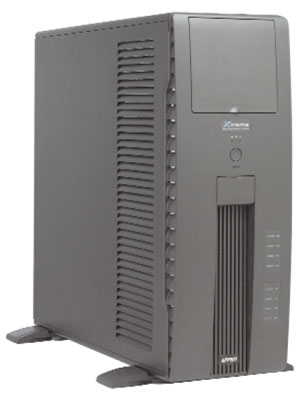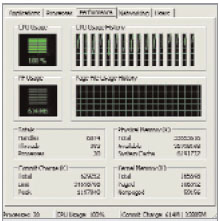New Super Quad-Core for Compute-Intensive Apps
Appro, a supercomputer manufacturer, delivers the Xtreme WH5548H workstation with four AMD Barcelona CPUs.
Latest News
December 4, 2001
By David Cohn
 The Appro Xtreme WH5548H workstation came equipped with four AMD quad-core Opteron CPUs, 32GB of memory, and a top-of-the-line NVIDIA Quadro FX 5600 graphicsboard as well as a single 250GB hard drive in its hot-swappable eight-slot drive cage. |
Appro International has been building rack-mount and high-density servers and blade clusters for more than 15 years. In fact, the Milpitas, California-based company recently won a contract to provide high-performance computing (HPC) clusters to the Lawrence Livermore, Los Alamos, and Sandia national nuclear laboratories. Appro also sells several lines of workstations aimed at MCAD, MCAE, petroleum exploration and production, and DCC users. Don’t worry — I had never heard of Appro before either. But with credentials like that, we were very interested when offered the opportunity to review its latest Xtreme WH5548H workstation, a system built around four AMD quad-core Opteron processors.
Yes, you read that right. The big black tower case that arrived at DE’s test lab contained four of AMD’s newest “Barcelona” CPUs for a total of 16 processor cores. Available in speeds ranging from 1.7 to 2.0GHz, the CPU is AMD’s first native quad-core processor. The new chip, based on a 65nm silicon-on-insulator (SOI) process, contains approximately 463 million transistors and incorporates a number of enhancements in terms of performance and power efficiency, including 512KB of L2 cache per core (2MB total per processor), 2MB of dynamically shared L3 cache, and an integrated 128-bit wide memory controller capable of being configured for dual 64-bit channels for simultaneous read/write capability.
Our evaluation unit was based on the 1.2-volt Opteron Model 8347, a CPU with a 1.9GHz frequency and 75W average power consumption (ACP, a new AMD metric the company says more clearly reflects typical usage).
As we were preparing for our review, AMD announced that it had identified an “erratum” in its first Barcelona CPUs. While a BIOS fix circumvents the flaw, the change could cause a reduction in performance of anywhere from 5 to 20 percent. A design correction in future chips will eliminate the problem, but since AMD wouldn’t have any of the revised chips available until sometime in the first quarter of 2008, we elected to go forward with our review of the Appro workstation in spite of the potential performance reduction.
Our evaluation unit was housed in a large black tower case measuring 7.87 in. x 23.75 in. x 21.75 in. (WxDxH) and tipping the scales at 67 pounds. A plastic door conceals three front-panel drive bays, two of which were filled with an 18X Sony/NEC DVD+/-R/RW optical drive and a Mitsumi 3.5-in. floppy. A second smaller door conceals two USB ports, a FireWire connection, and microphone and headphone jacks. A round power button is centered in the front panel below three activity lights, while an array of lights down the lower-right portion of the front panel indicates drive status for up to eight internal drives. Upon opening the case — by loosening two captive thumbscrews and removing the side panel — we found a stack of eight drive bays with hot-swap connections; the topmost bay in our test system contained a Western Digital 250GB 7200rpm SATA drive.
The system’s rear panel provides audio line-in, line-out, and headphone jacks, two SPDIF connections, a 15-pin VGA and 9-pin serial port, keyboard, two more USB 2.0 ports, an RJ-45 connection labeled KVM over IP, another FireWire connection, two Gigabit Ethernet ports, and an external SAS connection.
Inside the case, in addition to the stacked drive bays, we got our first look at the Uniwide Technologies motherboard. This unique board supports four AMD Opteron quad-core processors, two on the motherboard itself and two more on a large riser card. The motherboard has 16 memory sockets, eight on either side of the CPUs. The riser board provides another 16 sockets, for a total of 32. Our unit came with 32GB of memory using 16 2GB DDR2 DIMMs, four in each bank of sockets. We could have doubled the memory by simply adding more 2GB DIMMs. The system can accommodate up to 128GB of memory using 4GB DIMMs.
 With four quad-core processors installed,Task Manager saw a total of 16 CPUs, and during our AutoCAD benchmark, CPU usage reached100 percent when all 16 cores were active. |
The motherboard also provides seven PCI slots: four PCI-X 64-bit/133MHz slots (one of which was unusable because of the case configuration), a PCI-Express x4 slot, and two PCI-Express x16 slots. A top-of-the-line NVIDIA Quadro FX 5600 used up two of the expansion slots. A large 1000W Enermax Galaxy EGA1000EWL power supply fills the top portion of the case and provides ample power.
With four CPUs and 32 memory slots, we weren’t at all surprised at the number of fans: two 4.5-in. fans stacked vertically along the back of the case, two more between the drive cage and CPU stack (blowing air through the plastic ducts surrounding the CPUs), two in the power supply, and a small fan just in front of the graphics card. Add to that the fan on the NVIDIA card itself, and it’s no wonder that the Appro Xtreme WH5548H proved to be one of the noisiest systems we’ve ever encountered. It might be fine in a server room, but the din of the fans quickly became unbearable with the system positioned under a desk in a typical office environment.
Curious test results
When it came time to test the Xtreme WH5548H, we were quite curious as to what our tests would reveal, for several reasons. Click here to see the benchmarking chart. First of all, Appro chose Windows 2003 x64 Edition as the operating system due to the four CPUs and all that memory (64-bit Linux is also available); but almost all of our tests are 32-bit applications. 64-bit operating systems offer no real performance gain. They simply allow access to much more memory. Second, while the system had the equivalent of 16 processors, most standard benchmarks don’t show the benefits of multicore CPUs. And in the case of the Appro Xtreme, the new AMD Opteron processor was actually slower (by nearly 33 percent) than the latest Intel CPUs, even before factoring in the potential performance hit caused by the erratum fix.
Appro Xtreme WH5548H >Price: $9,217 as tested |
As we expected, on most of the standard SPEC viewperf and SolidWorks tests, the Appro Xtreme WH5548H turned in results approximately one-third slower than those of Intel dual quad-core equipped systems such as the Dell Precision 690 and HP xw8400. But on several of the viewperf datasets, the WH5548H results actually surpassed those of all previously tested systems. And when we ran our AutoCAD rendering test, we could definitely see the advantage of all of those processors. The Appro system completed the AutoCAD rendering test in exactly 60 seconds (when running AutoCAD 2008, a 64-bit application). When we ran the same test using AutoCAD 2007, however, the Appro finished 15 seconds behind the HP xw8400. We’d be very curious to see how these results change once AMD begins shipping its revised CPUs.
Our evaluation unit arrived without a keyboard or mouse. Appro leaves the purchase of those essential components to the customer. The company backs its systems with a two-year warranty covering parts and labor, with help-desk support from 8 a.m. to 5 p.m. PST Monday through Friday. Additional warranty services are available as extra-cost options.
Prices start at $5,375 for a system with two CPUs, 8GB of RAM, and an entry-level graphics card. Our evaluation unit, equipped with four AMD Opteron 8347 processors (which cost $786 each) as well as all that memory and the $2,999 NVIDIA Quadro FX 5600 graphics accelerator, would set you back $9,217.
While that makes the Appro Xtreme the most expensive workstation I’ve ever tested, it was actually less than I had anticipated. At present, we really can’t recommend this system for mainstream MCAD and modeling applications; it would simply be overkill for those programs. But for those running multithreaded compute-intensive applications (like simulations and multiphysics applications) or working with extremely large data sets, the large number of CPU cores and vast amounts of memory would provide clear benefits. If you can harness all those CPUs, the Appro Xtreme WH5548H is truly a marvel.
More Info
Appro International Inc.
Milpitas,CA
appro.com
Contributing Editor David Cohn is a computer consultant and technical writer based in Bellingham,WA, and has been benchmarking PCs since 1984. He’s an applications engineer with The PPI Group, and the author of more than a dozen books. Please send comments about this article to DE- [email protected]. You can also contact David at [email protected].
Subscribe to our FREE magazine, FREE email newsletters or both!
Latest News
About the Author
David Cohn is a consultant and technical writer based in Bellingham, WA, and has been benchmarking PCs since 1984. He is a Contributing Editor to Digital Engineering, the former senior content manager at 4D Technologies, and the author of more than a dozen books. Email at [email protected] or visit his website at www.dscohn.com.
Follow DE





